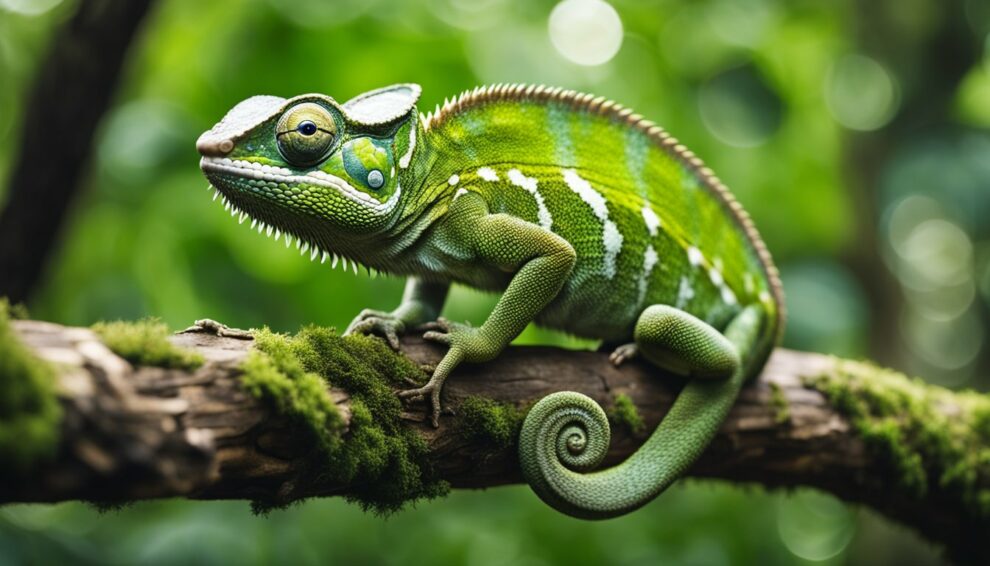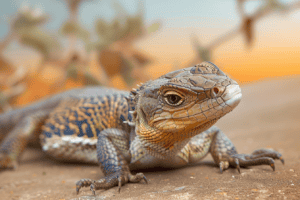Reptiles have developed an extraordinary skill to blend into their surroundings, evading predators and sneaking up on prey.
This adaptation, which we often call camouflage, is more than just a simple game of hide-and-seek; it’s a vital survival strategy in the wild.
From the color-changing chameleons to the motionless waiting of a well-hidden snake, these animals use their environment to their advantage in the most creative ways.

Can you imagine being able to change your skin color or pattern to match the place you’re sitting or standing?
That’s daily life for many reptiles. They can look like leaves, bark, sand, or even other animals.
This isn’t just cool—it’s incredibly clever!
This camouflage keeps them safe and hidden, allowing them to live their lives out of sight from both threats and their next meal.
When a reptile’s color and pattern are so close to their habitat’s appearance, it becomes almost impossible to spot them at first glance.
Their ability to stay still for a very long time adds to their inconspicuous presence.
But camouflage is not all about being invisible; sometimes, it’s about deception.
Some reptiles use what is called mimicry, where they might resemble something entirely unappetizing or dangerous to potential predators.
It’s a fascinating dance of colors, patterns, and behaviors in the vast theater of nature.
The Science of Camouflage
Camouflage is an art form in the animal kingdom, allowing creatures to blend into their surroundings to evade predators or surprise prey.
Types of Camouflage
Nature has equipped reptiles with a variety of camouflage techniques, each serving a unique purpose in their survival playbook.
Some species are masters of crypsis, where they hide by matching the colors and patterns of their surroundings.
Imagine a chameleon transition to the greens and browns of the leaves, nearly invisible against the foliage.
Others employ mimesis, where they mimic the appearance of objects, like a stick or a leaf; picture a twig snake staying motionless to look exactly like a branch.
A remarkable tactic is disruptive coloration, which involves bold patterns that break up the outline of an animal.
Stripes or spots can create an illusion, making it tough for a predator to spot the actual shape of, say, a leopard gecko against a backdrop of rocks and moss.
Last but not least, some reptiles can change color based on their environment, mood, or temperature — think of the panther chameleon displaying bright colors during courtship or turning dark when cold!
Biological Mechanisms
Have you ever wondered how these creatures magically transform their appearance? It’s all down to clever biology.
Reptiles like chameleons have specialized cells called chromatophores which contain various pigments.
Depending on the signals from the nervous system or hormonal changes, these cells can expand or contract, altering the color and pattern on the reptile’s skin.
Think of it as having a natural paint palette under their skin that they can control!
Then there are cells called iridophores and leucophores, which reflect light and can create iridescent or bright white colors, adding another layer to their concealment strategy.
Some species go even further; the clever cuttlefish (not a reptile, but still an excellent hider) can change not only its color but also the texture of its skin!
Wouldn’t it be amazing if you could do that?
Exploring the science behind reptiles’ camouflage is like uncovering superpowers they use to navigate their world.
Each variation of hiding is a testament to the incredible adaptations these animals have evolved over time to survive and thrive in the wild.
Reptiles and Their Camouflage Techniques

Reptiles are masters of disguise in the wild, employing various remarkable techniques to blend into their surroundings.
Now, let’s take a closer look at how these scaly survivors stay hidden in plain sight.
Chameleons’ Color Change
Chameleons are renowned for their ability to alter their skin color, and this change is not only for camouflage.
It’s also for communication and temperature regulation.
Specialized cells called chromatophores expand or contract to mix colors like paint on a canvas, creating hues that match their environment.
Believe it or not, chameleons can switch shades in just a few minutes!
Geckos’ Blending Skills
Imagine walking past a tree and never spotting the gecko hugging its bark.
Geckos use their incredible blending skills to mimic the textures and colors of their habitats.
They possess microscopic structures in their skin that scatter light, which helps them vanish from the watchful eyes of predators and prey alike.
Next time you’re near a tree, just think, there might be a gecko staring right back at you!
Crocodiles’ Stealth Methods
Have you ever pondered how a creature as large as a crocodile can hide so effectively?
Crocodiles’ stealth methods involve lying submerged with just their nostrils and eyes above the water surface.
Their bumpy, ridged skin resembles the murky waters of rivers and swamps, making them nearly imperceptible until they launch a surprise attack.
Many prey never see it coming, and that’s exactly how these reptiles like it.
Impact of Habitat on Reptilian Camouflage

Reptiles master the art of blending in, and their environs play a pivotal role in shaping these stealthy skills.
Each type of habitat presents unique challenges and opportunities for these cold-blooded inhabitants.
Desert Camouflage
In the vast, arid landscapes, reptiles such as the horned lizard take on the color of sandy browns and dusty tans to mimic their surroundings.
It’s not just about the right hue; the texture of their scales reflects the granularity of the desert.
A snake might slither unseen, its pattern mimicking the scattered rocks and sparse vegetation, a perfect adaptation for both predator and prey.
Forest Camouflage
Deep in the green embrace of the forest, reptiles display a palette of greens, browns, and yellows.
Take the chameleon, who has become synonymous with the term ‘camouflage’.
These lizards change their color to match the leaves and branches to hide from both their meals and the predators that are looking for a meal of their own.
The play of light through the trees also influences the speckled patterns seen on many of these forest denizens, offering a dynamic disguise in the dappled light.
Aquatic Camouflage
Water realms require a whole different level of concealment.
Turtles and aquatic snakes display dark tops and lighter undersides, a pattern known as countershading.
From above, they merge with the dark depths, while from below, they blend with the lighter surface.
This allows them to become nearly invisible to both the predators hunting from above and their prey below.
They glide through the water, unseen and often unnoticed, as they go about their day.
Think about how being invisible would help you play hide and seek.
Reptiles use the art of camouflage in their ultimate game of survival, where staying hidden is the key to success.
Imagine you are a lizard in the desert, a snake in the forest, or a turtle in the water. How would you blend in?
Challenges to Reptiles’ Camouflage

The art of blending in is not always easy for reptiles. They face a handful of difficulties that can make their camouflage less effective.
For example, habitat destruction is a major issue.
As humans build more and create various structures, the natural environments where reptiles live and camouflage themselves can be altered or even disappear.
Think about a chameleon that’s used to hiding among green leaves. What if those trees are cut down?
Suddenly, their green isn’t so stealthy anymore.
Seasonal changes also pose challenges.
Some reptiles are experts at changing their color or pattern to match the seasonal foliage, but what happens when seasons change rapidly?
If a reptile can’t adjust quickly enough, it might stand out like a sore thumb instead of blending in.
Have you ever seen a lizard lying on a rock, soaking up the sun?
Reptiles are ectotherms, meaning they rely on external heat to regulate their body temperature.
Sunbathing is essential for them, but it can also put them at risk. Why?
Well, while they’re warming up, they’re also more visible to predators. It’s tough being cold-blooded!
Predator adaptation is another hurdle. Some predators have evolved the ability to detect prey even when it’s camouflaged.
Have you heard of snakes that can see infrared light?
They can spot the warmth of a hidden animal’s body even if it blends into the background perfectly in visible light.
Finally, there are limitations in color adaptation.
Although many reptiles can change their skin color, they’re limited to certain hues.
If an environment has colors that a reptile can’t mimic, their cover could be blown.
Imagine a reptile that can only turn shades of brown and gray trying to hide on a bright pink flower!
Isn’t it intriguing how these masters of disguise have to navigate so many obstacles just to stay hidden?
The natural world is a complex puzzle, and every creature plays a part in solving it.
Frequently Asked Questions

Understanding reptiles’ camouflage abilities opens up a fascinating window into their survival strategies and how they interact with their environment.
Each question below explores a different aspect of this artistry, shedding light on the clever ways these creatures remain unseen.
How can understanding reptile camouflage help protect their species?
By studying how reptiles use camouflage, conservationists gain valuable insights into their needs and threats.
Recognizing the specific habitats where reptile camouflage is most effective can guide habitat preservation efforts and inform environmental policies that help protect these species from predators and human encroachment.
What are the most creative ways reptiles blend into their environments?
Some reptiles have evolved astounding camouflage techniques.
For instance, the leaf-tailed gecko‘s body mimics the shape and texture of foliage, making it nearly indistinguishable from actual leaves.
On the other hand, chameleons can change their skin color to match their surroundings, rendering them almost invisible to the untrained eye.
How do changes in a reptile’s habitat affect its ability to camouflage?
Habitat changes can severely impact a reptile’s camouflage capabilities.
When their natural environment is altered due to deforestation or urban development, reptiles may stand out against the new backdrop, making them more vulnerable to predators.
Studies show that this can lead to increased stress and potentially, a decline in population numbers.
In what fascinating ways do reptile colors change when camouflaging?
Reptiles display a variety of color change tactics.
Chameleons are famous for their vibrant color shifts, which are controlled by specialized cells in their skin called chromatophores.
These cells expand or contract to alter the reflection of light, allowing the chameleon to match its colors with the environment or communicate with other chameleons.
What role does reptile behavior play in effective camouflage?
Behavior is key to successful camouflage.
For example, many snakes remain motionless when a threat is nearby, relying on their patterned skin to blend in with the ground or foliage.
Some species will also flatten their bodies or adjust their orientation to enhance the effect of their physical camouflage, maintaining the illusion.
Can you list some reptiles that are masters of disguise and explain their techniques?
The masters of disguise in the reptile world employ a variety of tactics.
The horned lizard, for instance, not only has a desert-toned patterned back but can also bury itself in the sand, leaving only its eyes exposed.
Meanwhile, the Gaboon viper‘s intricate pattern allows it to disappear amidst the forest floor’s leaf litter, waiting patiently for unsuspecting prey.









